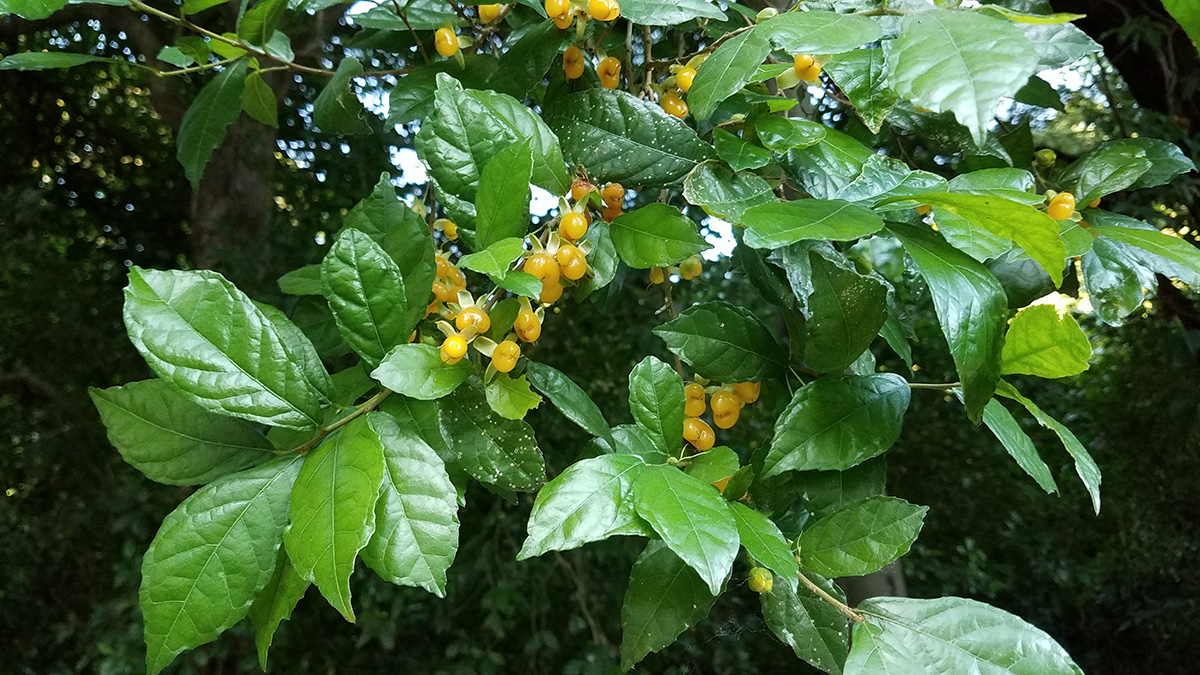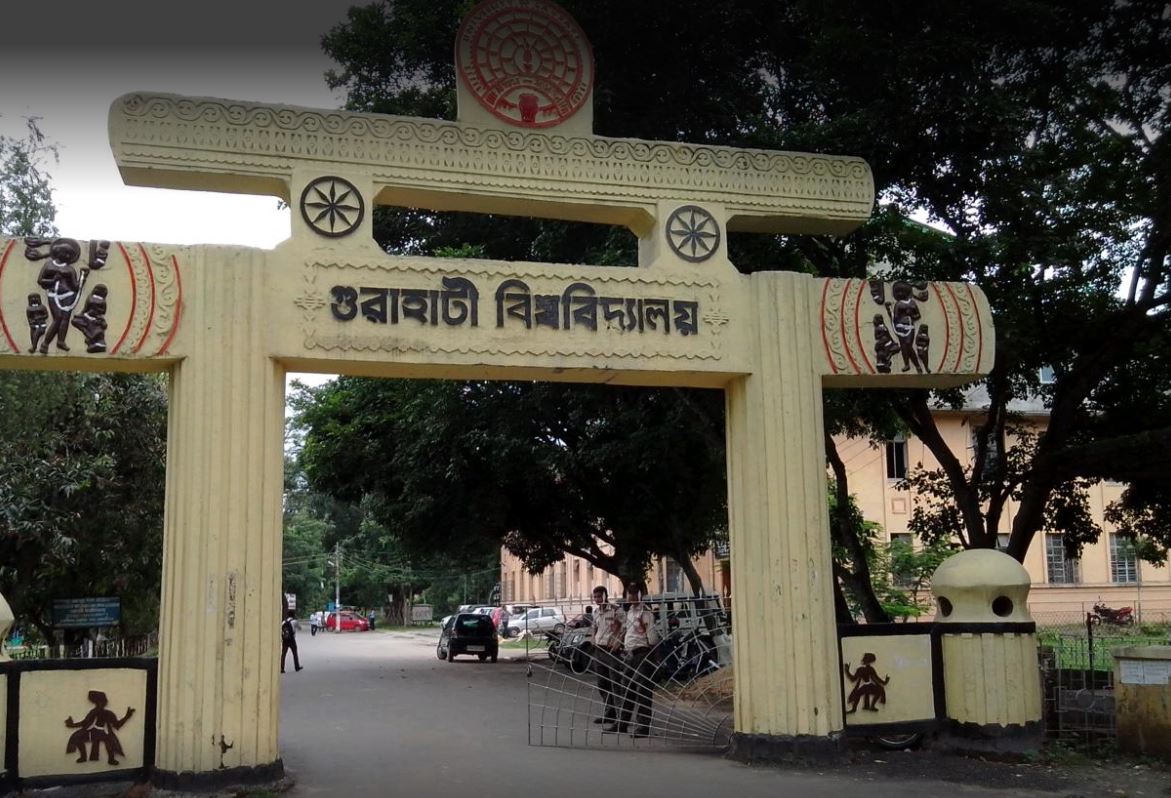Streblus asper: An Ethnomedicinal Boon of Northeast India
By: Dr. Sudarshana Borah Khanikor*, Gouranga Boruah, Riya Salam, Lobsang Tashi
School of Pharmaceutical Sciences, University of Science and Technology Meghalaya
The use of plants in various ailments and in healthcare is a well-known practice throughout the world since centuries. From the very beginning of the human race till today there are a total of 391000 plant specimen discovered. As the advancement of the human race people started using the plants around them for different purposes like ornamental, as food, as clothing etc (Samy et al., 1999). India is also one hotspot for the use of various ethnomedicinal plants for curing different ailments. The country has a rich variety in using of medicinal plants. 1500 plants out of 15000 species are known to be used medicinally in India. India around its states and union territories has a number of tribes and languages. The different local tribes from various geographical regions have different diverse and unique cultures and ethnic foods. These cultures are a rich source of these ethnomedicinal plants in the country (Upasani et al., 2017). These beliefs of using plants as medicines are deeply rooted in those cultures as different systems like Ayurveda, Siddha and Unani has a brief history in the country, starting from the Himalayas to the western Ghats and the dry Rajasthan (Pandey et al., 2017). The North-Eastern region of the country is also very rich in different species of plants that are used by the local communities and most of them are undiscovered till now. Because of this region the central government is laying down various programmes for conservation of those (Rai & Lalramnghinglova, 2011). Different plants specimens are used to commonly to cure different ailments like, skin problems, digestive problems, kidney stones, diabetes, wound healing, snake bites, piles, fever, dental problems, diarrhoea, etc. As the North-Eastern region is high in humidity and heavy rainfall is observed in this region, the flora is more diversified here (Choudhury et al., 2012). In case of state Meghalaya, more than 80 percent of the population is belongs to thee scheduled tribes and most of the area is rural. The state is dominated by various communicable diseases out of which the Diarrhoea is one of the major ones. But, the local communities are very much close to nature and their traditional beliefs and practices are controlling these diseases from spreading further and from being fatal. A major part of this state is still undiscovered botanically while it is having various valuable plant species out there (Laloo & Hemalatha, 2011). The state Tripura is known for using traditional plants for curing 15 different disease categories majorly the digestive disorders, and respiratory system disorders (Choudhury et al., 2015). The Jayantia tribe of North-East India use around 40 different specimens to cure 30 types of ailments. They use different parts of the plants like the root, tubers, rhizomes etc. This tribe is one of the predominant residents of North Cachar Hills of Southern Assam (Sajem & Gosai, 2006). As a whole, it can be concluded that India and specifically North eastern India has a rich biodiversity of medicinal plants and traditional healing practices. But, recent urbanization in the geographical hotspots of these plants, different construction projects, and unplanned use and deforestation are affecting these valuable resources. Proper planning for saving those and study to know their benefits should be carried out to use them for development of mankind. As it has been known that around 70% of the allopathic medicines are also based on these ethnomedicinal plants, those species having high market value should be cultivated using modern agro-technology for better yield. The local communities should be educated on conservation, proper cultivation and on the market values of those medicinal plants (Das, 2016).
Streblus asper belonging to family Moraceae. It is indigenous to Philippines, Malaysia, Thailand, Sri Lanka, and India. This species used traditionally throughout these countries, mainly India to cure a number of ailments including dental issues, plaque, toothache, diarrhoea, dysentery, diabetes, leprosy, hyperlipidemia, fever, different inflammatory conditions and even cancer. The tree has a number of common uses in various parts of the World, in Thailand it is one of the potential sources for paper making. Streblus asper serves as a versatile resource, with sweet edible fruits, leaves for tea and cleaning, medicinal seeds, animal fodder, ornamental potential, valuable timber, and as a source of fuel in the form of firewood and charcoal, mainly in Vietnam (Ibrahim et al., 2013, Kumar et al., 2012, Sripanidkulchai et al. 2009). In India, mostly in the North Eastern region the local communities use this plant for curing various ailments. Local tribes and communities of Assam and neighbouring states use the soft stems of Streblus asper as dental sticks to get rid off various dental disorders and for better dental health. It is commonly known as ‘Sora’ in Assam and it is believed to be a reason for better and long lasting dental health of old age people in the state (Hazarika and Dutta, 2013). The scientists have found that the plant is very rich in cardiac glycosides, triterpinoids as well as phytosterols (Zhu et al., 2019). The Streblus asper shows a promising antimicrobial activity against microbes associated with dental caries (Wongkham et al., 2001). The extract of the plant also has macrofilaricidal activity towards Litomosoides carinii and Brugia malayi in rodents (Chatterjee et al., 1992). The antioxidant study of the Streblus asper using DPPH method reveals its strong antioxidant property. This promising antioxidant activity of the plant can add to the need for searching natural antioxidants because of harmful preservatives in the market (Ibrahim et al., 2013). Intraperitoneal administration of extract of Streblus asper in rats reveals its anti-inflammatory effect. It is used as traditional anti-inflammatory agent in different ailments (Sripanidkulchai et al., 2009).
TAXONOMICAL CLASSIFICATION (Tripathi et al., 2014)
Kingdom: Plantae – Plants
Division Magnoliophyta – Flowering plants
Superdivision: Spermatophyta – Seed plants
Class: Magnoliopsida – Dicotyledons
Order: Urticales
Family: Moraceae
Genus: Streblus Lour.
Species: Streblus asper Lour
VERNACULAR NAMES
English: Sand Paper Tree, Siamese rough bush, Toothbrush tree
Hindi: Daheya, Dahia, Karchanna, Rusa, Sahora, Sihora
Marathi: poi, karera, kharoli, kharota, sahor
Indonesia: Serut
Tamil: kurripila, kuttippirai, parayan, pasuna
Malayalam: parakam, paruva, sakhotavrksam, tinda-parua
Telugu: baranika, baranki, barinika
Kannada: akhor moranu, mitala
Assamese: khorua, saura gach
Khasi: dieng sohkhyrdang
Sanskrit: akshadhara, bhutavasa, bhutavriksha, dhukavasa, gavakshi, karkashachhada
Streblus asper is known for its abundance of cardiac glycosides. Reichstein and his research team have successfully extracted more than 20 cardiac glycosides from the root bark of S. asper, and they have meticulously identified the structures of approximately 15 of these compounds, primarily through the use of degradative methods. These characterized compounds include kamloside, asperoside, strebloside, indroside, cannodimemoside, strophalloside, strophanolloside, 16-O-acetylglucogitomethoside, glucogitodimethoside, glucokamloside, sarmethoside, and glucostrebloside. Additional glycosides identified in the root bark encompass b-sitosterol-3-O-b-d-arabinofuranosyl-O-a-l-rhamnopyranosyl-O-b-d-glucopyranoside, lupanol-3-O-b-d-glucopyranosyl-[1-5]-O-b-d-xylofuranoside (Prasanth et al., 2021), and vijaloside, specifically periplogenin-3-O-b-d-glucopyranosyl-[1-5]-O-b-d-xylopyranoside (Zhu et al., 2019).
From the stem bark of Streblus asper, researchers have successfully isolated compounds such as a-amyrin acetate, lupeol acetate, b-sitosterol, a-amyrin, lupeol, and diol (Phutdhawong et al., 2004), strebloside, and mansonin (Rawat et al., 2018). Additionally, a pregnane glycoside known as sioraside (Kumar et al., 2013) has been isolated. The aerial parts of the plant yielded n-Triacontane, tetraiacontan-3-one, b-sitosterol, stigmasterol, betulin, and oleanolic acid. An unidentified cardenolide, b-sitosterol, a-amyrin, and lupeol were also isolated from the root bark and leaves (Sivamaruthi et al., 2022).
In the case of the volatile oil obtained from fresh S. asper leaves, it was extracted at a 0.005% yield and presented as a brown liquid. The primary components of the volatile oil included phytol (45.1%), a-farnesene (6.4%), trans-farnesyl acetate (5.8%), caryophyllene (4.9%), and trans-trans-a-farnesene (2.0%). Other constituents comprised a-copaene, b-elemene, caryophyllene, geranyl acetone, germacrene, d-cadinene, caryophyllene oxide, and 8-heptadecene (Tripathi et al., 2014).
Oral diseases including periodontal diseases and dental caries affect people globally. Use of conventional toothpastes is the most common way of maintaining dental health. But, most of toothpastes contain various harmful chemicals like alcohol, Aspartame, fluoride, artificial colouring, carrageenan, cocamidopropyl betaine, diethanolamine, parabens, sodium Lauryl Sulphate etc. Hence, this era is very much demanding the need of natural based toothpastes or dental care products. Use of those conventional toothpastes are degrading the dental health in long term basis, prolonged use of fluoride toothpastes is causing fluorosis (yellow teeth). They can also cause gastro-intestinal blockages, intestinal symptoms, vomiting and even cancer (Kanouté et al., 2022). In this research, we are formulating a chewable dentifrice that contains the extract of Streblus asper. Chewable dentifrice is a chewing gum material which can add to proper cleansing of teeth without using of water that is eco friendly as well as user friendly. These are toxin free and they are free of all those harmful chemicals and preservatives in conventional toothpastes. These chewable dentifrices can be an alternative for patients suffering from fluorosis. The frequent travellers, campers would be benefitted through the dentifrice because of its user-friendly nature. The gummy formulation helps to induce teeth whitening action and getting rid of halitosis (bad breath). The active ingredient in the chewable dentifrice is the extract of the ethnomedicinal plant Streblus asper. The antimicrobial, antioxidant, analgesic, and anti-caries activity of the Streblus asper increases the potentiality of the formulation by inducing those properties.
Correspondence: shonapharma@gmail.com
9954603711
References
- Bai Y, Zhu W, Xu Y, Xie Z, Akihisa T, Manosroi J, Sun H, Feng F, Liu W, Zhang J. (2019) Characterization, quantitation, similarity evaluation and combination with Na+, K+-ATPase of cardiac glycosides from Streblus asper. Bioorganic Chemistry. 1;87:265-75.
- Chatterjee, R. K., Fatma, N., Murthy, P. K., Sinha, P., Kulshrestha, D. K., & Dhawan, B. N. (1992). Macrofilaricidal activity of the stembark of Streblus asper and its major active constituents. Drug Development Research, 26(1), 67-78.
- Choudhury, P. R., Choudhury, M. D., Ningthoujam, S. S., Das, D., Nath, D., & Talukdar, A. D. (2015). Ethnomedicinal plants used by traditional healers of North Tripura district, Tripura, North East India. Journal of Ethnopharmacology, 166, 135-148.
- Choudhury, S., Sharma, P., Choudhury, M. D., & Sharma, G. D. (2012). Ethnomedicinal plants used by Chorei tribes of Southern Assam, North eastern India. Asian Pacific Journal of Tropical Disease, 2, S141-S147.
- Das, R. (2016). Biodiversity of Ethnomedicinal plants used by the ethnic tribal people of Barpeta district of Assam, North East India. Asian Journal of Pharmaceutical Science and Technology, 6(1), 27-32.
- Hazarika, P., & Dutta, D. (2013). Traditional knowledge for using plant resources as tooth brushing stick (datun) by the indigenous communities of Assam, India. International Journal of Herbal Medicinal, 6(6), 22-34.
- Ibrahim NM, Mat I, Lim V, Ahmad R. (2013) Antioxidant activity and phenolic content of Streblus asper leaves from various drying methods. Antioxidants;2(3):156-66.
- Ibrahim, N. M., Mat, I., Lim, V., & Ahmad, R. (2013). Antioxidant activity and phenolic content of Streblus asper leaves from various drying methods. Antioxidants, 2(3), 156-166.
- Kanouté, A., Dieng, S. N., Diop, M., Dieng, A., Sene, A. K., Diouf, M., ... & Carrouel, F. (2022). Chemical vs. natural toothpaste: which formulas for which properties? A scoping review. Journal of Public Health in Africa, 13(3).
- Kumar RS, Kar B, Dolai N, Bala A, Haldar PK. (2012) Evaluation of antihyperglycemic and antioxidant properties of Streblus asper Lour against streptozotocin–induced diabetes in rats. Asian Pacific Journal of Tropical Disease. 1;2(2):139-43.
- Kumar, R. B., Kar, B., Dolai, N., Karmakar, I., Haldar, S., Bhattacharya, S., & Haldar, P. K. (2013). Antitumor activity and antioxidant role of Streblus asper bark against Ehrlich ascites carcinoma in Swiss albino mice. Journal of experimental therapeutics & oncology, 10(3).
- Laloo, D., & Hemalatha, S. (2011). Ethnomedicinal plants used for diarrhea by tribals of Meghalaya, Northeast India. Pharmacognosy reviews, 5(10), 147.
- Pandey, A. K., Mishra, A., Shukla, S. P., Sharma, A., & Tripathi, N. N. (2017). Ethnomedicinal plants used by the tribals of Kalahandi district of Odisha, India. Indian Journal of Traditional Knowledge, 16(2), 317-326.
- Phutdhawong, W., Donchai, A., Korth, J., Pyne, S. G., Picha, P., Ngamkham, J., & Buddhasukh, D. (2004). The components and anticancer activity of the volatile oil from Streblus asper. Flavour and fragrance journal, 19(5), 445-447.
- Prasanth, M. I., Brimson, J. M., Sheeja Malar, D., Prasansuklab, A., & Tencomnao, T. (2021). Streblus asper Lour. exerts MAPK and SKN-1 mediated anti-aging, anti-photoaging activities and imparts neuroprotection by ameliorating Aβ in Caenorhabditis elegans. Nutrition and Healthy Aging, 6(3), 211-227.
- Rai, P. K., & Lalramnghinglova, H. (2011). Ethnomedicinal plants of India with special reference to an Indo-Burma hotspot region: An overview. Ethnobotany Research and Applications, 9, 379-420.
- Rawat, P., Kumar, A., Singh, T. D., & Pal, M. (2018). Chemical composition and cytotoxic activity of methanol extract and its fractions of Streblus asper leaves on human cancer cell lines. Pharmacognosy magazine, 14(54), 141.
- Sajem, A. L., & Gosai, K. (2006). Traditional use of medicinal plants by the Jaintia tribes in North Cachar Hills district of Assam, northeast India. Journal of ethnobiology and ethnomedicine, 2, 1-7.
- Samy, R. P., Ignacimuthu, S., & Raja, D. P. (1999). Preliminary screening of ethnomedicinal plants from India. Journal of ethnopharmacology, 66(2), 235-240.
- Sivamaruthi, B. S., Prasanth, M. I., Kesika, P., Tencomnao, T., & Chaiyasut, C. (2022). Functional properties of Streblus asper Lour.: a review. Food Science and Technology, 42, e113421.
- Sripanidkulchai B, Junlatat J, Wara-aswapati N, Hormdee D. (2009) Anti-inflammatory effect of Streblus asper leaf extract in rats and its modulation on inflammation-associated genes expression in RAW 264.7 macrophage cells. Journal of Ethnopharmacology. 30;124(3):566-70.
- Tripathi, A. K., Tripathy, S., & Verma, N. K. (2014). A study on pharmacognostic and chemomicroscopic features of Streblus asper L. Der Pharm Lettre, 6(5), 30-36.
- Upasani, S. V., Beldar, V. G., Tatiya, A. U., Upasani, M. S., Surana, S. J., & Patil, D. S. (2017). Ethnomedicinal plants used for snakebite in India: a brief overview. Integrative medicine research, 6(2), 114-130.
- Wongkham, S., Laupattarakasaem, P., Pienthaweechai, K., Areejitranusorn, P., Wongkham, C., & Techanitiswad, T. (2001). Antimicrobial activity of Streblus asper leaf extract. Phytotherapy Research, 15(2), 119-121.




















